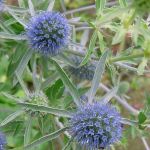| Common Name: |
Sea Holly |
| Other Names: |
Eryngo |
| Botanical Name: |
Eryngium maritimum |
| Genus: |
Eryngium |
| Family: |
Apiaceae |
| Native Location: |
Coastal sands and gravel in Europe, N Africa, and SW Asia |
| Cultivation: |
Damp, heavy soil in sun or shade with ample warmth and humidity all year (E. foetidum); well-drained, sandy or stony soil in sun (E. maritimum). |
| Propagation: |
By seed sown when ripe; by root cuttings in late winter. Seeds of E. maritimum are sown in spring after stratifying for 4 weeks. |
| Harvest: |
Leaves (E. foetidum) are picked before flowering; roots of second-year plants are lifted in autumn and used fresh for flavoring, and fresh or dried for infusions and decoctions. Roots of E. maritimum are lifted in autumn and used fresh for conserve, or dried for use in powders, decoctions, and flavorings. |
| Height: |
30-45cm (12-18in) |
| :Width |
30-45cm (12-18in) |
| Hardiness: |
Z6-9 |
| Parts Used: |
Leaves, Roots |
| Properties: |
A sweet, mucilaginous herb that is diuretic, anti-inflammatory, and expectorant. |
| Medicinal Uses: |
Internally for urinary infections, especially cystitis, urethritis, excessive urine production (as in diabetes), prostate complaints, and renal colic. |
| Culinary Uses: |
Roots are boiled or roasted like parsnips. Once candied, they are made into a conserve and used to flavor jellies and toffee. |
| Bibliography: |
Encylopedia of Herbs by Deni Brown Copyright ©: 1995, 2001 Dorling Kindersley Limited pp 204-205
|

